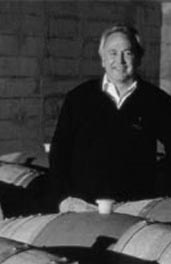Are you If not, could you forward this site to this person? |
|
 |
 infomore |
I have done this site especially for Terry Peabody |
Terry Peabody is director of Craggy Range Vineyards Ltd
 |
 |
 |
Sorry for my poor english translation.
A vineyard is a field, or more broadly an area planted with vines (eg Jura vineyards of Beaujolais, Bordeaux, Irouleguy, Bellet ...).
In appointing a plot planted with vines, we use instead the term "vineyard". In the context of wine, "closed" (as surrounded by walls in most cases) is synonymous with the connotation of a small area of ??quality property, eventually assumed more noble (cf. Clos Vougeot in Burgundy, Clos du Mesnil Champagne).
Land or a land of vineyards planted with specific skills to produce a wine typed (soil, climate, codified knowledge ...) is called by occurrence "terroir" vintage "climate" (Burgundy) . The vineyards are systems that unify titles and meet with fairly strict rules, at least in Europe (see Appellation d'origine contrôlée, AOC)
The expressions on the vineyards and qualifying can not possibly appear on the labels that under specific conditions, under the rules of the Institut National des Appellations d'Origine (INAO).
---
Extension of the vineyard
The total area of ??vineyards worldwide was 7.886 million hectares in 2000, including:
Europe: 62.7% (France 11.6, Italy 11.5, Spain 14.9).
Asia: 19.2% (China 3.3)
America: 11.9% (U.S. 5.2, Argentina 2.7 Chile 2.2).
Africa: 4.3 (South Africa 1.5).
Oceania: 1.9% (Australia 1.8).
The share of Europe decreases (loss of 4 points since 1996) while that of other continents is increasing.
Environmental Impacts
In recent decades, the vineyards have been or still are a major source of pollution of soil and water pollution (surface or underground) and the ecosystem by pesticides and in particular lead arsenate (formerly) and copper (left by the Bordeaux mixture) in recent decades, two products that are not biodegradable). Other pesticides (herbicides, fungicides, insecticides) can leave many residues and degradation of molecules more or less toxic to some of them in soil, water or air.
The program MEDALUS showed that in the south of the EU in the arid region, the vineyards contributed most to the degradation and soil erosion (semi-natural groves protecting the best)
The risks posed by experiments or projects transgenic vines are still the subject of a dissent.
---
Vegetation
Secondarily, in addition to many species classified as weeds, can be found in the vineyard a few species whose remarkable heritage or
vines garlic (Allium vineale L.)
ornithine in the umbel (Ornithogalum umbellatum L.)
the wild tulip (Tulipa sylvestris ssp sylvestris L.)
the Muscari (Muscari neglectum Guss. ex Ten. Muscari comosum & L.)
pledged the fields (Gagea villosa M. Bieb.)
order of the fields (Calendula arvensis L.)
the ground-cherry (Physalis alkekengi L.)
Aristolochia (Aristolochia Clematis L.)
----
Australia has a long history of wine. Paradoxically, this country has become the archetype of the new wine-producing country: international grapes, wine brand, consistent use of new technologies and flying winemakers (a term denoting the original Australian winemakers consultants), and finally a production wine meeting the tastes of international markets. However, Australia has always put on export and it has now become a leader with the 6th largest world producer and the fourth largest global exporters of wine. Technological innovation, competition and exports: perhaps it is in this that the Australian tradition.
Australia wine history
The first plantings of vines in Australia date back to 1788, the site of present city of Sydney.
In 1801, Napoleon Bonaparte, who seeks to learn about this new land, learn that Australia is destined to become the vineyard of England.
In 1822, Gregory Blaxland first Australian wine exports to London.
In 1831, James Busby, a young Scottish-born gardener, undertook a trip to France and Spain which he reports 600 slips of vines.
In the 1840s, Australian wine production benefits from the arrival of many European immigrants who brought with them their expertise, while increasing the population and domestic demand for wine.
The years 1850 to 1872, exports to Britain rose from 7,000 gallons to 32,000 gallons of wine per year. They reach 50,000 gallons in 1900, then representing 3.5% of all wine imported into England.
From the late 19th century, Australian producers are involved in different competitions at international fairs, notably in Paris in 1855, in London in 1862, in Vienna in 1873, in Philadelphia in 1875 and Bordeaux in 1882. Some win awards.
From 1873, the State of Victoria, then the main wine producing region, was devastated by phylloxera. This favors the emergence of other regions, including South Australia.
After the First World War, it converts the demobilized soldiers in viticulture, and it follows a crisis of overproduction in which the government responds with export subsidies.
Between 1925 and 1960, Australia produces and exports mainly fortified wines of Port or Sherry style then in vogue in Anglo-Saxon.
The 1950s marked the return of dry wines, red and white, accompanied by a great interest in scientific and technological innovations. It was then that Max Schubert, Penfolds produced its first Grand Hermitage.
From the mid-1960s, producers adopt the best international varieties and new technologies. Simultaneously, professionals develop a multitude of small areas: the wines shops.
During the years 1990 and 2000, exports of Australian wine, supported by the government, are experiencing phenomenal growth. The volume of wine exported increased 500% between 1995 and 2005.
Today, the main export market remains the United Kingdom, followed by the United States and Canada. In England, the consumption of Australian wine now exceeds that of French wines.
The laws of wines in Australia
Wine production in Australia is regulated by the Australian Wine and Brandy Corporation. The law is fairly simple and mainly regulates the content of labels:
To be labeled a vintage, a wine must contain at least 85% of grapes from this vintage
There are no restrictions on the use of grape varieties in different regions. If a wine is labeled with a single varietal, it must consist of at least 85% of the blend. If different grape varieties make up the wine, they must be listed in descending order.
To be labeled a region of origin, a wine must be composed of at least 85% of grapes from this region. Australian law recognizes different regions and sub-wine regions.
Grape varieties of the vineyard in Australia
Red Wines
The red wines of Australia are mainly produced from grapes:
Cabernet Sauvignon
Shiraz
Merlot
Pinot Noir
White wines
Australian white wines are produced primarily from grapes:
Chardonnay
Semillon
Riesling
Muscat
Chenin
Colombard
Sauvignon
Characteristics of wines
For years, Australia has specialized in the production of fortified wines. This partly explains the taste of Australian wines for strong alcohol and intense flavors (Michel Phaneuf, The News, 1 June 2004). Indeed, Australian wines are characterized by a high concentration of flavors and a high degree of alcohol. It remains difficult to define the characteristics of different Australian wines. Also note that currently, most major areas and production are concentrated in the hands of a few large publicly traded companies such as Foster's Wine Estates (Wolf Blass, Penfolds, Rousemnount and Lindemann), Constellation Brands, Pernod Ricard Pacific . This explains the industrial and commodified in many Australian wines.
Otherwise, there are almost as many Australian wine producer that while the features of each correspond mainly to different grape varieties and wine choices. If there are differences in climate and soil types, their specificity is still not clearly reflected in the wines produced by each region. That said, the Australian Wine and Brandy Corporation, the government body responsible for regulating production and trade of wine in Australia has established an administrative structure that allows producers to submit applications for specific regions known to be their specific wines.
Viewed from outside, Australia is seen as an immense territory. But the wine regions are concentrated in just 10% of Australian territory, mostly in the cooler regions of the south coast. Australia now has about sixty wine regions and 103 "Defined Geographic Indications". That said, the main areas through which it gathers the vineyard designations remain the country's administrative divisions States.
New South Wales is the state in southeastern Australia. Here the first vineyards were planted. Among others the Hunter Valley region where viticulture has evolved since long due to the proximity of the city of Sydney. It was here that was founded in 1870 Lindemans home, now present in all regions of Australia.
Victoria is the southernmost state in the eastern part of Australia. In the late 19th century, the state produced more than half of Australian wine and vineyards counted 1200. With New South Wales located just above these two major regions produce wines of Australia. This is the area of ??Murray River, which produces the majority of wines in Victoria.
South Australia, located in south-central Australia produces a lot of cheap wine. Since the early 20th century, South Australia is by far the largest state in terms of quantity of wine produced. This region is the Australian equivalent of the Central Valley in California. It includes among others the Barossa Valley region, where is located the House Penfolds and Wolf Blass. We also find the Coonawarra region which produces some of the most famous wines of Australia.
Western Australia is the region that occupies the entire western Australia. The vineyards are in the south, mainly concentrated around the Swan Valley. If the first vineyards date from the 1840s, viticulture has never been important because of the remoteness of this region compared to urban centers in the east. Since 1980, Viticulture be experiencing a revival and the region is rapidly gaining recognition.